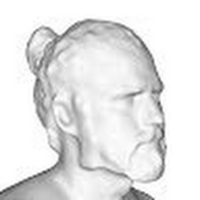Research Interests:
Research Interests:
Research Interests:
Research Interests:
This paper presents partial results of a larger validation study of different Data-driven 3D Reconstruction (D3DR) technologies developed by IBV to create watertight 3D human models from measurements (1D3D), 2D images (2D3D) or raw scans... more
This paper presents partial results of a larger validation study of different Data-driven 3D Reconstruction (D3DR) technologies developed by IBV to create watertight 3D human models from measurements (1D3D), 2D images (2D3D) or raw scans (3D3D). This study quantifies the reliability (Standard Error of Measurement, SEM; Mean Absolute Deviation, MAD; Intra-class Correlation Coefficient, ICC; and Coefficient of Variation, CV) of body measurements taken on human subjects. Our results are also compared to similar studies found in literature assessing the reliability of digital and traditional anthropometry. Moreover, we assess the compatibility (bias and Mean Absolute Error, MAE) of measurements between D3DR technologies. The results show that 2D3D can provide visually accurate body shapes and, for the measurements assessed, 2D3D is as reliable as high resolution 3D scanners. It is also more accurate than manual measurements taken by untrained users. Due to accessibility, cost and portab...
Research Interests:
Size mismatch is a serious problem in online footwear purchase because size mismatch implies an almost sure return. Not only foot measurements are important in selecting a size, but also user preference. This is the reason we propose... more
Size mismatch is a serious problem in online footwear purchase because size mismatch implies an almost sure return. Not only foot measurements are important in selecting a size, but also user preference. This is the reason we propose several methodologies that combine the information provided by a classifier with anthropometric measurements and user preference information through user-based collaborative filtering. As novelties: (1) the information sources are 3D foot measurements from a low-cost 3D foot digitizer, past purchases and self-reported size; (2) we propose to use an ordinal classifier after imputing missing data with different options based on the use of collaborative filtering; (3) we also propose an ensemble of ordinal classification and collaborative filtering results; and (4) several methodologies based on clustering and archetype analysis are introduced as user-based collaborative filtering for the first time. The hybrid methodologies were tested in a simulation stu...
Research Interests: Mathematics, Computer Science, Artificial Intelligence, Data Mining, Recommender Systems, and 9 moreClassification (Machine Learning), Clustering and Classification Methods, Supervised Learning Techniques, Unsupervised Learning Techniques, Collaborative Filtering, Classification, Cluster Analysis, Archetype, and Footwear
Research Interests:
Research Interests:
Research Interests: Humanities and Art
Research Interests:
Research Interests:
Research Interests:
Research Interests:
Research Interests:
Research Interests:
Research Interests:
Research Interests:
Research Interests:
Research Interests:
El principal objetivo del Proyecto InKreate (https://www.inkreate.eu/) es facilitar el desarrollo del diseno de moda (de la idea a los detalles tecnicos) y el proceso de toma de decisiones mediante la creacion de un software adaptado... more
El principal objetivo del Proyecto InKreate (https://www.inkreate.eu/) es facilitar el desarrollo del diseno de moda (de la idea a los detalles tecnicos) y el proceso de toma de decisiones mediante la creacion de un software adaptado exclusivamente a las necesidades del sector de la moda. La herramienta InKreate incluira cuatro caracteristicas principales que la diferenciaran de las soluciones CAD/CAM actuales (diseno y fabricacion asistidos por ordenador): los disenadores podran disenar directamente sobre una forma corporal en 3D, que incluye un escaneo corporal real, una plantilla corporal derivada a partir de datos estadisticos o un modelo de avatar en 3D creado en un software de terceros; el proceso de diseno combinara la manipulacion de las formas y el esbozo intuitivo; la herramienta integrara un analisis preliminar del coste del diseno; la interfaz permitira a los disenadores gestionar colecciones de disenos y tambien sus ideas. En este articulo presentamos los resultados pre...
